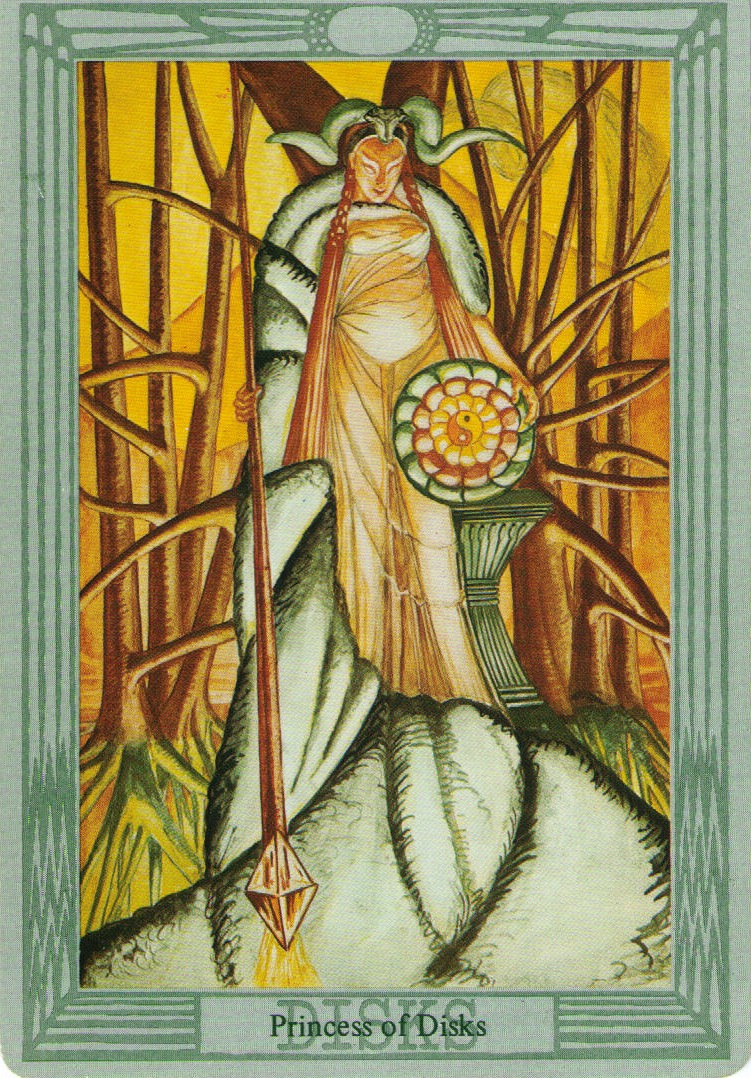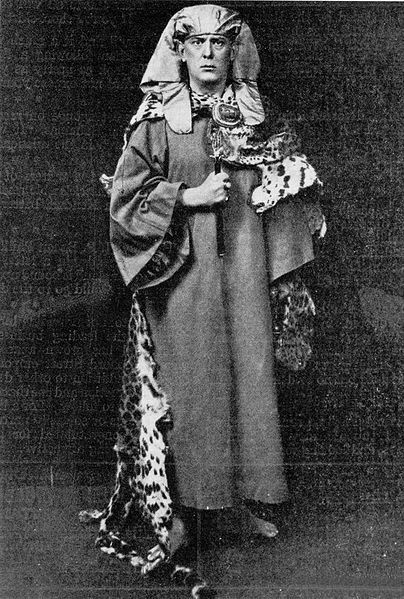The Numinous
"I have never grown out of the infantile belief that the universe was made for me to suck." -Aleister Crowley
At some murky time in my own distant past, I saw a few Tarot cards. There were women with horns, and smiling faces with blank Greek statue eyes and insect wings. I could not imagine what the cards were meant to illustrate, but I wanted them so much that they continued to appear in my dreams over the years. I therefore had no trouble recognizing them, when my first boyfriend was teaching me how to read Tarot cards and I happened upon the Thoth tarot deck.
 Beautifully painted by Lady Frieda Harris, apparently following exacting instructions from Mr. Crowley (who wrote a characteristically grandiose book about the tarot called "The Book of Thoth"), the Thoth tarot is enchanting. It is brimming with the images derived from an overwhelmingly rich experience of spiritual symbology, with a strongly Egyptian bent. Mr. Crowley himself was an odd man. Photos show him looking like a grim version of Christopher Lloyd. In the priestly raiment of the Order of the Golden Dawn (a prestigious occult society to which the poet Yeats belonged), he looked flamboyantly like a bouncer at the Luxor in Las Vegas. A feckless libertine, Mr. Crowley enjoyed a great deal of sex with both men and women, and was an enthusiastic user of recreational drugs. After dropping out of Cambridge, he wrote prolifically about his spiritual escapades while travelling widely across the globe. Having survived a fall off a cliff in China, a volcano eruption in Mexico, and bankruptcy over a lawsuit in England, Mr. Crowley, alone in the wake of a tragic family life, died of complications from heroin use.
Beautifully painted by Lady Frieda Harris, apparently following exacting instructions from Mr. Crowley (who wrote a characteristically grandiose book about the tarot called "The Book of Thoth"), the Thoth tarot is enchanting. It is brimming with the images derived from an overwhelmingly rich experience of spiritual symbology, with a strongly Egyptian bent. Mr. Crowley himself was an odd man. Photos show him looking like a grim version of Christopher Lloyd. In the priestly raiment of the Order of the Golden Dawn (a prestigious occult society to which the poet Yeats belonged), he looked flamboyantly like a bouncer at the Luxor in Las Vegas. A feckless libertine, Mr. Crowley enjoyed a great deal of sex with both men and women, and was an enthusiastic user of recreational drugs. After dropping out of Cambridge, he wrote prolifically about his spiritual escapades while travelling widely across the globe. Having survived a fall off a cliff in China, a volcano eruption in Mexico, and bankruptcy over a lawsuit in England, Mr. Crowley, alone in the wake of a tragic family life, died of complications from heroin use.
The Thoth cards, despite their freaky beauty and the care with which they were imagined and executed, didn't quite satisfy me. Mr. Crowley seemed excessively devoted to an intricate synthesis of the world's spiritual and occult traditions (he unwisely named his first daughter Nuit Ma Ahathoor Hecate Sappho Jezebel Lilith). Some of the cards were crowded tight with Mr. Crowley's elaborate language of occult traditions, and I amused myself trying to imagine poor Lady Harris rolling her eyes as he demanded she add more planetary glyphs and symbolic animals to an already full card. Often I felt annoyed by the deck's demanding pushiness; the cards were intended to mean something very particular indeed, and it felt as though my own creative imagination and ideas were uninvited guests.
Mostly, Mr. Crowley never seemed to experience a moment of self-doubt or bewildered wonder. I got the sense, from his Book of Thoth, that he understood every word that he was saying. Frankly, I found that  strange. For someone fascinated with as much esoteric magicky spiritualism as Mr. Crowley, he seemed terribly concerned with sounding as though he knew what he was talking about. If there are any general rules of mysticism, they are that there are aspects of the world that are incomprehensible to the human mind, that these aspects give profound meaning to human existence, and that human beings are able to experience the incomprehensible. Ultimately, Mr. Crowley did not seem to have that experience (despite having heard a disembodied voice which he believed to be an Egyptian god). He had reasons for everything.
strange. For someone fascinated with as much esoteric magicky spiritualism as Mr. Crowley, he seemed terribly concerned with sounding as though he knew what he was talking about. If there are any general rules of mysticism, they are that there are aspects of the world that are incomprehensible to the human mind, that these aspects give profound meaning to human existence, and that human beings are able to experience the incomprehensible. Ultimately, Mr. Crowley did not seem to have that experience (despite having heard a disembodied voice which he believed to be an Egyptian god). He had reasons for everything.
As much as I love the Thoth deck, and will always love it, I wanted the freedom to interpret the images according to my world and my internal mythology, rather than according to the impassable mountain ranges of the many traditions of human history. Tarot cards, to me, have always been a modular way of telling stories about the mysteries of the world. I like that the cards themselves should remain mysterious and interpretable in a variety of ways. I was dissatisfied with the man behind the Thoth tarot, and I believe that this is what inspired me to make my own deck of Tarot cards.
This post is part of a series about my deck, the Cheimonette Tarot.